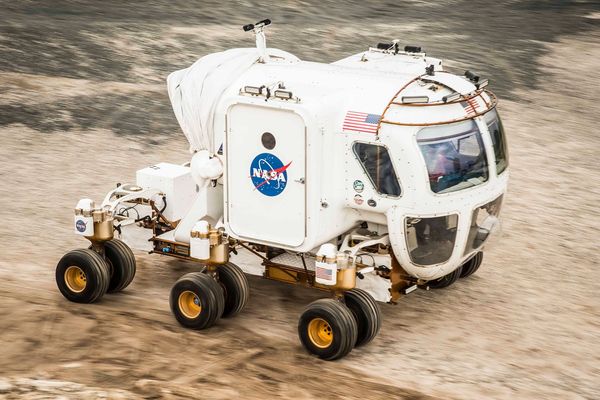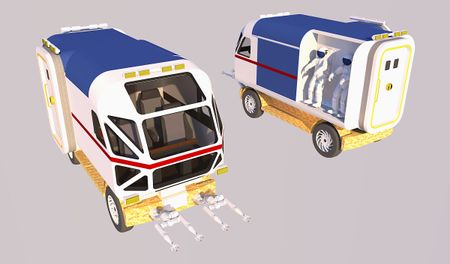Difference between revisions of "Rover"
(Long ranged rovers may use CH4 and O2. Fixed spelling error.) |
|||
| Line 27: | Line 27: | ||
Mars rovers cover a large variety of vehicles that have been developed for mission planning and Science Fiction movies. Most of the manned designs are close to the proposed SEV design. Rovers could be automated or carry passengers, and would likely have major differences in design depending on the tasks they are designed to achieve. | Mars rovers cover a large variety of vehicles that have been developed for mission planning and Science Fiction movies. Most of the manned designs are close to the proposed SEV design. Rovers could be automated or carry passengers, and would likely have major differences in design depending on the tasks they are designed to achieve. | ||
| − | A typical specification might call for a pressurized cabin, large windows, external manipulator arms, back entry suits and suit-ports as well as full sized docking ports. Wheels on Mars need to be designed for the major temperature swings, and very low temperatures compared with Earth. Radiation protection could use water or ice in a double walled hull | + | A typical specification might call for a pressurized cabin, large windows, external manipulator arms, back entry suits and suit-ports as well as full sized docking ports. Wheels on Mars need to be designed for the major temperature swings, and very low temperatures compared with Earth. Radiation protection could use water or ice in a double walled hull.A base platform could be modified to provide specialized functions such as a crane, an exploration vehicle, a semi or an ore hauler. Electrical power might come from a 50-200 kWh rechargeable battery pack. For longer ranged rovers, the rover might burn methane (CH<sub>4</sub>) and oxygen (O<sub>2</sub>) for power, as these would be produced as locally made rocket fuels. |
===Life support=== | ===Life support=== | ||
Revision as of 14:53, 22 September 2024
The term Rover as used here describes any all-terrain vehicle designed to traverse the surface of a planet, moon, or asteroid. It allows exploring the surface on a variety of places, collecting and examining Minerals, taking photos. The first rover (Lunokhod 1) was unmanned and remote controlled on Earth's Moon in 1970. During the Apollo missions in the 1970s rovers have been used manned to extend the exploration range of the crew. It was not until 1997 that the first rover landed successfully on Mars. A rover is a type of Surface Vehicle.
A martian settlement would require a number of rovers for transportation, exploration and various construction functions. This is an active area of research for the Mars society, to understand how rovers can aid in the development of Martian bases.
Contents
Successful Mars rovers
- Sojourner (1997)
- Spirit (2004)
- Opportunity (2004)
- Curiosity (2012)
- Zhurong (2021)
- Perseverance 2021)
Planned Mars rovers
- The ExoMars rover by ESA has been named after Rosalind Franklin[1]. The plan was to launch in July 2020. However, cooperation with Russia is now halted and the ESA is searching for other solutions[2]
- The Mars 2020 rover was named Perseverance, launched in the summer of 2020, and landing on Feb 18, 2021.[3]
- The Beaver rover was planned as part of the Canadian Northern Light mission.
Space Exploration Vehicle (SEV)
The SEV is a planned manned rover that was tested by NASA form 2009 to 2013[4]. Full scale prototypes were built and tested. The MMSEV (Multi Mission Space Exploration Vehicle) was a variant that could be used for space missions.
Mars Manned Rovers Requirements
Mars rovers cover a large variety of vehicles that have been developed for mission planning and Science Fiction movies. Most of the manned designs are close to the proposed SEV design. Rovers could be automated or carry passengers, and would likely have major differences in design depending on the tasks they are designed to achieve.
A typical specification might call for a pressurized cabin, large windows, external manipulator arms, back entry suits and suit-ports as well as full sized docking ports. Wheels on Mars need to be designed for the major temperature swings, and very low temperatures compared with Earth. Radiation protection could use water or ice in a double walled hull.A base platform could be modified to provide specialized functions such as a crane, an exploration vehicle, a semi or an ore hauler. Electrical power might come from a 50-200 kWh rechargeable battery pack. For longer ranged rovers, the rover might burn methane (CH4) and oxygen (O2) for power, as these would be produced as locally made rocket fuels.
Life support
A manned vehicle needs to maintain adequate air quality and interior temperature to keep humans inside alive for prolonged periods of time. It is likely that life support systems used in spaceships will be adapted for the rovers, with lowered and more specialised functionality. Heat loss may be a significant issue during Martian nights, and the energy balance of the vehicle needs to be studied. Ideally, the material used for radiation protection would also be a good insulator.
Note that storage for life support items such as food and water will have to be provisioned inside the rover in case of emergency and to enable longer mission duration. Food often has a more strict requirement on storage.
Radiation protection
Radiation protection on a rover is limited, due to space and mass constraints. Frozen water was suggested as a good material for the SEV, in double walls. Plastic materials would be better than aluminium or steel in regards to high Energy cosmic radiation. Solar storm warnings would be helpful to ensure occupants could reach a shelter in case of a large scale radiation event, and also allow for planning missions around periods of high radiation. Near term spacecraft being designed by space agencies such as the Lagrange mission are paving the way for space weather monitoring on a large scale, and similar missions could help Mars space weather monitoring.
Power
The are two possible power sources for a Mars rover: Batteries and fuel.
- Batteries have the advantage of having a long history in vehicle power, and are used more and more frequently on Earth. They can also be recharged by on board solar panels, such as demonstrated in the novel and movie 'The Martian'. Cold temperatures tend to have major negative effects on the lifespan of most high capacity technologies. The more recent Mars rovers such as Curiosity and Mars 2020 have opted away from batteries and solar panels partially for this reason.
- Fuel, potentially the same fuel as for the spaceships going to Mars, is another possibility. The mass ratio is better than for batteries, although reduced because the vehicle also needs to carry the oxygen for combustion, if a combustible fuel. Most hydrocarbon based fuels would have to be created when on Mars, which although possible would be a costly method initially. fuel can be burned with oxyg3en in an engine to produce direct mechanical power, or more likely in a fuel cell to produce electricity to drive an electrical engine.
- RTGs are a possibility for small rovers as they provide both heat and energy, but have dangers and major regulations around their use. Plus the power available from existing RTGs is OK for very slow rovers, but would not be enough to move a rover designed for human occupation.
As both fuel and batteries have the same ultimate power source, be it solar or nuclear, conversion efficiency also comes into play in the overall analysis.
Robert Zubrin suggested using Silane (SiH4) as a fuel since it will burn using Carbon Dioxide. It produces SiO2 as a solid waste product (which is unsuitable for internal combustion engines), but could be used in a boiler for a steam powered vehicle.
Wheels
Wheels and suspensions are a significant challenge for a Mars rover. The extreme cold of Martian nights and winters can reach the glass transition phase of most materials. This makes the wheel materials brittle and destroys them. The swings in temperature can also cause damage to many materials, and any material used would have to function correctly in the wide range of temperatures experienced. A possible solution is solid metallic wheel, as for the Curiosity Rover. Alternatively, wire wheels were used successfully by the Apollo Moon Rover, and have recently been re-developed by NASA[5]. Another note is that radiation can cause organic molecules such as carbon based materials (plastics for instance) to deform and become very different and inconsistent materials. These issues could mean regular replacing of wheels, or storage of rovers in radiation shielded environments.
References
- ↑ "ESA's Mars Rover Has a Name - Rosalind Franklin" Press release about ExoMars naming.
- ↑ "Second ExoMars mission moves to next launch opportunity in 2020" (Press release). European Space Agency. 2 May 2016. Retrieved 2 May 2016.
- ↑ https://mars.nasa.gov/mars2020/ Mars 2020 mission homepage.
- ↑ https://ntrs.nasa.gov/archive/nasa/casi.ntrs.nasa.gov/20140004223.pdf
- ↑ https://www.nasa.gov/specials/wheels/








